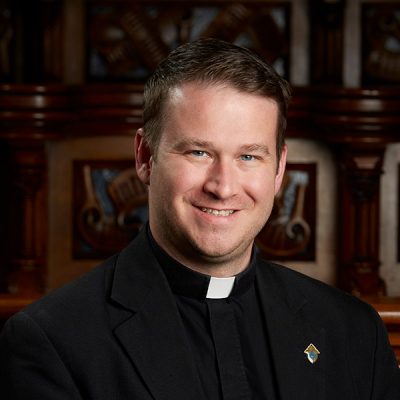From Our Pastor: 3rd Sunday of Easter
 These readings this weekend are super powerful! Today we hear St. Peter’s first homily and 3000 people were converted and baptized. How truly amazing the Holy Spirit is when he speaks through such broken vessels as his bishops, priests and deacons. Peter gives us a little synopsis of what Christ has done in light of the Old Testament. He follows Jesus’ example and how he uses typology to point forward to what Jesus had just done. We then hear from Peter again in the second reading, as he tells us to focus on imperishable and eternal realities. Expounding most especially on us who are baptized, and washed in the blood of the lamb, and how our hope is in Him who was resurrected. That resurrection we received ourselves in our baptism and reception of communion.
These readings this weekend are super powerful! Today we hear St. Peter’s first homily and 3000 people were converted and baptized. How truly amazing the Holy Spirit is when he speaks through such broken vessels as his bishops, priests and deacons. Peter gives us a little synopsis of what Christ has done in light of the Old Testament. He follows Jesus’ example and how he uses typology to point forward to what Jesus had just done. We then hear from Peter again in the second reading, as he tells us to focus on imperishable and eternal realities. Expounding most especially on us who are baptized, and washed in the blood of the lamb, and how our hope is in Him who was resurrected. That resurrection we received ourselves in our baptism and reception of communion.
And then we jump to Luke’s Gospel today, and the familiar story of the Road to Emmaus, but how many of us have realized that this story is about the mass. Luke tells us that Jesus finds these two who are fleeing from Jerusalem because they’ve lost hope. They tell us it’s Cleopas and another disciple. We know that Cleopas is his uncle, and most likely then the other disciple is his aunt. Remember during the crucifixion, Mary and Mary’s sister, the wife of Cleopas and Mary Magdalene and John, remained by the cross. So we know that this is his uncle and most likely aunt, but they were kept from recognizing him as the Scriptures tell us.
It’s not that they didn’t know him or they wouldn’t recognize him, but that he is veiled, most especially because of their lack of faith and hope. They had lost hope even though they not only knew of the crucifixion, but had also heard of the empty tomb. They did not get it. Jesus then encounters them where they are, which is what he does in the mass and walks with us, but for the purpose of getting us to go the direction we should, which is Jerusalem, in the story which points to heaven for us.
This is the penitential rite in the first part of the mass. Jesus then opens up the Scriptures and by scriptures we mean Old Testament, he then goes through the typological, prefigurements and prophetic declarations that point to what Jesus was to do, and what he had just done and fulfilling it all. This would have been the greatest Old Testament scripture study ever. Wouldn’t we want to know exactly what he said because their hearts burned within them as he spoke. This, brothers and sisters, is the first part of the mass, called the liturgy of the word, which then does include a Homily to expound on the scriptures in the example that Jesus gives us.
And this was no short Homily. They were so moved by this that they asked him to stay with them and this is where we should be and how we should feel by the Scriptures. We too should be moved where we beg Jesus to stay with us. And this is the second part of the mass, the liturgy of the Eucharist, because Jesus takes bread, blesses it, breaks it and shares it. The last time Luke used these words: take, bless, break and share, in reference to the bread at the last supper. Jesus is reenacting the institution of the Eucharist, and we call this the liturgy of the Eucharist. And in the breaking of the bread, their eyes were opened and they saw him. Finally, in seeing the breaking of the bread in the Eucharist, the veil was lifted and their eyes were opened and they didn’t see him in body anymore, but they saw him in body, blood, soul and divinity in the Eucharist.
They didn’t recognize him standing in front of them as we often think of if we just had that experience how easy it would be to follow, but they did recognize him in the breaking of the bread in the Eucharist, and we are privileged to see Him in this way every Sunday if we just allow the Spirit to open our eyes. And their response to recognizing him is to get up and run back the right way to Jerusalem/Heaven. And there they witness to Jesus truly present in His resurrected flesh in the breaking of the bread in the Eucharist. May we have the joy and excitement to go forth, and do the same.
-Rev. Steven Arisman
